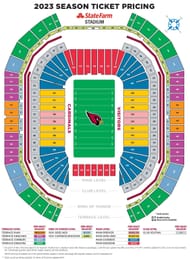
State Farm Stadium Home Venue
State Farm Stadium is located in Glendale, Arizona, United States of America. It is the home venue of the NFL team, Arizona Cardinals, presently starring players like Elijah Wilkinson, Kyzir White and Michael Wilson among others. The stadium has grown to become a multi-purpose venue which is used to host sports and cultural events including concerts. Considering Arizona’s climate, the roof has been made retractable so that it can be used all year round.
State Farm Stadium Capacity
The State Farm Stadium can house close to 63,400 people for football games. However, since it is a multi-purpose venue that also hosts cultural events and concerts, the stadium can seat up to 72,000 people on account of floor seating as well as its regular seating capacity. The stadium has a total space of 1.7 million square feet of space. The annual attendance at the State Farm Stadium is 1.2 million on average. This stands testament to how big of a stadium it is and the appeal of the events that are held within the stadium.
State Farm Stadium History
The team Arizona Cardinals initially played at the football stadium of Arizona State University until the development of a full-fledged stadium just for the Cardinals. The team eventually started to feel frustrated at not having their own stadium. This lack of an individual stadium prevented many sources of revenue.
This initiated the bid by many cities to construct a stadium for the Arizona Cardinals. This bid was won by Glendale and the stadium was built. State Farm Stadium was originally named the Cardinals Stadium. It was inaugurated in 2006. It was renamed as the University of Phoenix Stadium due to a sponsorship deal requirement and the name was changed again to State Farm Stadium in the year 2018. The stadium is known to have hosted many historical events within football which include
State Farm Construction and Cost
The State Farm Stadium was inaugurated in 2006 after 3 years of its construction. The stadium was designed by Eisenman Architects, founded by the American Architect named Peter David Eisenman. The stadium was announced as one of the top 10 sports facilities in the world due to its architectural features, which include not just a retractable roof but also a retractable field so as to host other events. Considered to be an engineering feat, the playing field is created on a single tray with 546 wheels. In a time span of 70 minutes, the entire field can be moved in or out of the stadium.
The stadium cost a sum total of $455 million which was broken up into $17 million for the land, around $395.5 million for the stadium itself and around $41.5 million for improvements.
State Farm Stadium Seating Chart
The State Farm Stadium’s seating chart has been designed to provide a stellar view of the game from all angles and all seat levels. It includes multiple seating levels such as field level, main concourse, club level, loft level and terrace level. The stadium has a seating capacity of 72,200 seats.

What to bring to State Farm Stadium
The State Farm Stadium has strict rules enforced on what visitors are allowed to bring to events. The State Farm Stadium has a clear bag policy that allows visitors to carry only certain items in their bags. The dimensions of such bags must be 12 x 6 x 12. If the bag is not transparent, the bag that the visitor is carrying can be no bigger than 4.5 x 6.5 in dimension. This policy has been extended to the NFL at large rather than just limiting the policy to one team. The official team logo plastic tote bags are sold at the merchandise shop inside the stadium. All ticket holders irrespective of age are allowed to carry one purse or bag.
What is the Parking Cost at State Farm Stadium?
State Farm Stadium has multiple parking options for visitors. Parking fees vary based on the event type and the proximity of the parking area to the event space. Prices typically range from anywhere between $10 to $30. There are also premium parking options available to visitors. The stadium’s parking capacity is high, being able to host up to 14,000 vehicles. The stadium also offers season passes for parking which range from $350 for standard-size vehicles and $750 for oversized vehicles.
Parking Map

The State Farm Stadium parking map allows visitors to locate parking spaces within and near the stadium. These include parking spaces near the stadium vis-a-vis those that are located away from the stadium.
All in all, the State Farm Stadium is a modern and versatile event space which functions primarily as the home field of the NFL team, Arizona Cardinals. It has a rich history, impressive seating capacity and innumerable amenities for visitors. Watching their team play on this field, Arizona Cardinal fans and their opponents are bound to have a wonderful experience at the State Farm Stadium.
FAQs
A. The AT&T Stadium is the stadium with the largest capacity in the NFL. It has a seating potential of 1,00,000 people.
A. The listed capacity of State Farm Stadium is 63,400. This seating capacity can expand to 73,000.
A. The State Farm Stadium is featured by retractable roofs which close during hot weather in order for the stadium to be air-conditioned.
A. Yes, each ticket holder is allowed to carry an approved bag into the stadium. The contents of the bag will be checked at the gates of the stadium.
A. The State Farm Stadium is known to be a cashless venue. Cash transactions are not allowed at any point of purchase. However, customers have the option of using their debit cards through the cash-to-card kiosk.









